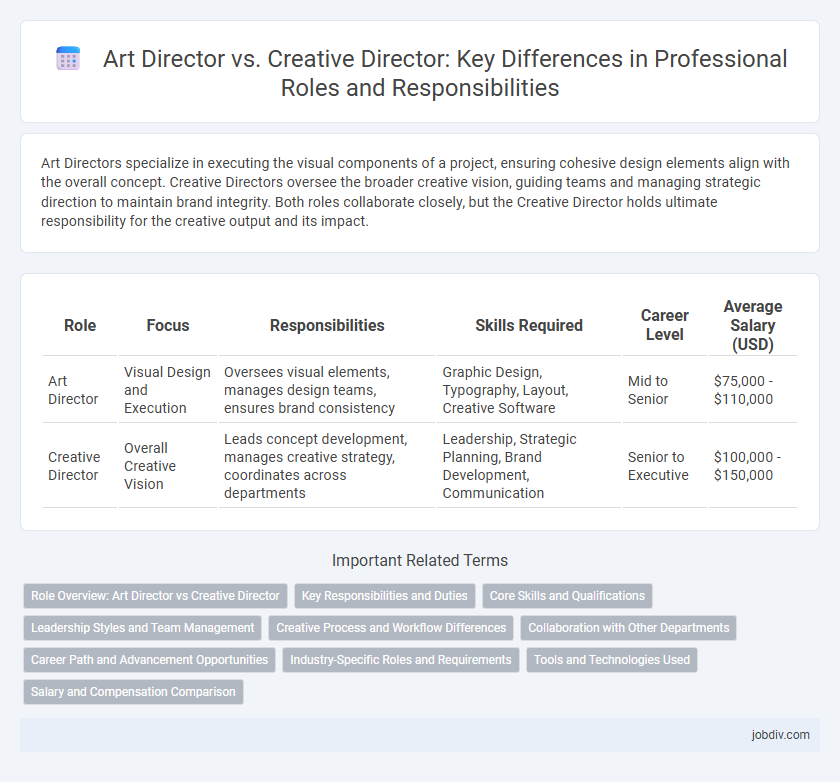Art Directors specialize in executing the visual components of a project, ensuring cohesive design elements align with the overall concept. Creative Directors oversee the broader creative vision, guiding teams and managing strategic direction to maintain brand integrity. Both roles collaborate closely, but the Creative Director holds ultimate responsibility for the creative output and its impact.
Table of Comparison
| Role | Focus | Responsibilities | Skills Required | Career Level | Average Salary (USD) |
|---|---|---|---|---|---|
| Art Director | Visual Design and Execution | Oversees visual elements, manages design teams, ensures brand consistency | Graphic Design, Typography, Layout, Creative Software | Mid to Senior | $75,000 - $110,000 |
| Creative Director | Overall Creative Vision | Leads concept development, manages creative strategy, coordinates across departments | Leadership, Strategic Planning, Brand Development, Communication | Senior to Executive | $100,000 - $150,000 |
Role Overview: Art Director vs Creative Director
Art Directors focus on the visual style and imagery in advertising, magazines, product packaging, and movie and television productions, ensuring cohesive design elements across projects. Creative Directors oversee the entire creative vision, managing teams, guiding project concepts, and aligning creative strategies with business goals. Both roles require strong collaboration, but Creative Directors hold broader responsibilities in strategic decision-making and client communication.
Key Responsibilities and Duties
An Art Director primarily focuses on the visual style and imagery in advertising campaigns, coordinating designers, photographers, and illustrators to create cohesive aesthetics. A Creative Director oversees the overall creative vision, managing teams across multiple disciplines to ensure brand consistency and alignment with strategic goals. Both roles require leadership, but the Creative Director holds broader responsibilities including concept development and client communication.
Core Skills and Qualifications
Art Directors excel in visual design, composition, and typography, with strong expertise in graphic software and hands-on creative execution. Creative Directors possess advanced leadership abilities, strategic thinking, and brand development experience, often guiding multidisciplinary teams and aligning creative outputs with business objectives. Both roles require exceptional communication skills, a deep understanding of marketing principles, and a portfolio demonstrating innovation and conceptual strength.
Leadership Styles and Team Management
Art Directors focus on executing the creative vision by guiding the design team with hands-on leadership, emphasizing detail-oriented management to ensure visual consistency. Creative Directors adopt a broader leadership style, inspiring innovation and strategic thinking across multidisciplinary teams while aligning creative outputs with business goals. Effective team management for Art Directors centers on daily project supervision, whereas Creative Directors cultivate collaborative environments that foster long-term creative growth and brand development.
Creative Process and Workflow Differences
Art Directors focus on the visual execution of concepts, managing design elements like typography, color palettes, and imagery to ensure cohesive aesthetics. Creative Directors oversee the broader creative strategy, guiding the overall vision, concept development, and team collaboration to align projects with brand goals. Workflow differences highlight that Art Directors handle detailed production tasks, whereas Creative Directors prioritize strategic direction and cross-functional communication throughout the creative process.
Collaboration with Other Departments
Art Directors and Creative Directors collaborate closely with marketing, production, and client service teams to ensure cohesive project execution. Art Directors focus on translating the creative vision into tangible designs, working alongside graphic designers and photographers to realize visual elements. Creative Directors oversee the broader strategy, aligning creative outputs with brand goals and facilitating communication between creative departments and executive leadership.
Career Path and Advancement Opportunities
Art Directors typically advance from graphic design or illustration roles, gaining expertise in visual storytelling and project management, while Creative Directors often progress from Art Director positions or senior creative roles, developing broader leadership skills and strategic vision. Career advancement for Art Directors involves specializing in visual design leadership, whereas Creative Directors focus on overseeing entire creative teams and aligning creative strategy with business goals. Both roles offer pathways to executive positions such as Chief Creative Officer, but Creative Directors generally have greater influence over brand direction and organizational strategy.
Industry-Specific Roles and Requirements
Art Directors primarily focus on overseeing the visual style and imagery in advertising, publishing, and media industries, requiring strong skills in graphic design, typography, and layout. Creative Directors hold a broader role that encompasses conceptualizing overall campaign strategies, managing creative teams, and aligning creative outputs with business goals, often necessitating extensive leadership experience and strategic thinking. In industries such as marketing, film, and fashion, the Creative Director typically sets the creative vision while the Art Director executes it through detailed visual development.
Tools and Technologies Used
Art Directors primarily utilize design software such as Adobe Photoshop, Illustrator, and InDesign to create visual concepts and layouts. Creative Directors leverage project management tools like Asana, Trello, and digital collaboration platforms including Miro and Slack to oversee creative workflows and team communication. Both roles increasingly incorporate emerging technologies like augmented reality (AR) and virtual reality (VR) to enhance creative presentations and client engagements.
Salary and Compensation Comparison
Art Directors typically earn an average salary ranging from $60,000 to $90,000 annually, while Creative Directors command higher compensation, often between $100,000 and $160,000 depending on industry and company size. Bonus structures and profit-sharing plans significantly enhance the total compensation package for Creative Directors, reflecting their broader strategic responsibilities. Location and experience further influence salary disparities, with Creative Directors in major markets like New York or Los Angeles earning premiums over their Art Director counterparts.
Art Director vs Creative Director Infographic

 jobdiv.com
jobdiv.com